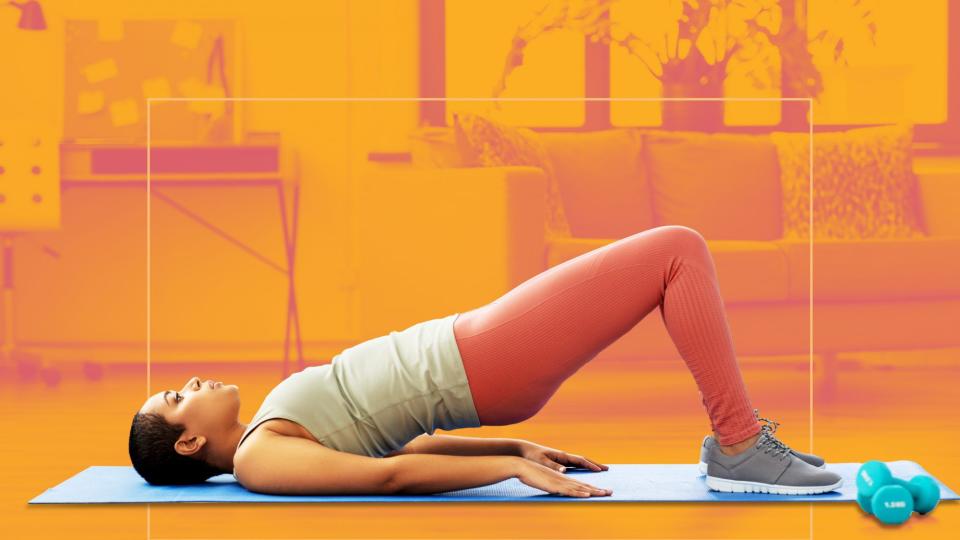The Best Exercises for Lower Back Pain Relief
If you're reading this, you've probably experienced lower-back pain at least once in your life. The list of possible reasons for this low back pain is long, to say the least.
Yep, "the variety of types of lower back pain is mind-boggling," as Evie Vlahakis, a certified physical therapist based in New York City, puts it. For starters, anyone can have lower back pain due to posture, genetics, lifestyle, work injuries, sports injuries, or simply from sitting for long periods of time. (Thank you, desk job!) In older adults, arthritis (the inflammation of joints or surrounding tissue) and stenosis (a narrowing of the spinal canal) are also commonly to blame, says Vlahakis. "The truth is, everything can intertwine since 'low back pain' is such a general and vague term," says Vlahakis. "It can be an accumulation of repetitive strains or minor injuries." Lower back pain can be acute, meaning sudden, or it can be latent, which indicates that the pain shows up after an initial injury, she adds. (Related: The Most Common Causes of Back Pain—Plus, How to Ease Your Aches ASAP)
If you're dealing with lower back pain, your best bet is to visit a physical therapist, osteopath, physiatrist, or orthopedist, who can help you find out the root cause of the problem, says Vlahakis. Physical therapists can analyze your posture, stance, and gait while walking and running, and test your flexibility and mobility throughout various movement patterns, she says. They'll then use the observations to create a therapy program that can "strengthen what is weak and stretch what is tight, improve alignment and [correct] any muscular imbalances that exist," which can all lead to reduced back pain, she explains. (Related: How Discovering Reformer Pilates Finally Helped My Back Pain)
But there are small steps you can take at home in order to prevent lower back pain before it really impacts your life and activity. Maintaining strong core muscles (which include your abs, obliques, the back muscles that stabilize your spine, your diaphragm, and your pelvic floor muscles) can help you avoid putting excess strain on your lower back. "Activities like yoga, Pilates, and [tai chi] are safe ways to strengthen for prevention [of low back pain] if you cannot lift weights or tolerate impact," notes Vlahakis. Using correct posture while sitting at your desk, standing, and walking, can also make a difference, she says. (Related: Effed Up Your Back? Do These Gentle Exercises to Relieve Pain)
But if you're already hurting at this point, lower back exercises for pain relief may also be helpful. The below five exercises from Annette Marshall Franey, a certified physical therapist based in East Hampton, New York, fit the bill. These exercises "help alleviate low back pain by increasing blood flow to the lower back area, thereby decreasing stiffness and expediting healing," says Marshall Franey. Together they strengthen your abdominal muscles, promote spinal flexibility, and alleviate stress in the lower back. To fully take advantage of the benefits, Marshall Franey suggests performing these moves twice per day.

Getty Images
Best Exercises for Lower Back Pain
Pelvic Tilt
A. Start lying face-up with feet flat on the floor and hip-width distance apart, knees bent.
B. Inhale, and keeping butt connected to the floor, slowly arch spine to lift belly button and low back toward the ceiling.
C. Exhale, and draw belly button toward the floor to flatten lower back. (Butt may lift slightly.)
Do five reps.
Abdominal Isometric Hold
A. Start lying face-up with feet flat on the floor and hip-width distance apart, knees bent.
B. Inhale. Exhale, and draw belly butt toward spine, tightening abdominal muscles. Hold for five seconds.
Do five reps.
Lower Trunk Rotation Stretch
A. Start lying face-up with feet flat on the floor and hip-width distance apart, knees bent.
B. Keeping shoulders flat on the floor, drop both knees over to the right. (Low back may lift off the floor some to accommodate twist.) Hold five seconds, then raise knees toward the ceiling to return to starting position.
Do two to three reps. Switch sides; repeat.
Single-Knee Hug
A. Start lying face-up with feet flat on the floor and hip-width distance apart, knees bent.
B. Lace hands together behind right thigh close to the knee, drawing knee into chest until reaching a comfortable stretch in the lower back and hip. Keeping abdominals tight, hold for five seconds.
C. Unlace hands and return foot to floor to return to start.
Do two to three reps. Switch sides; repeat.
Glute Bridge
A. Start lying face-up with feet flat on the floor and hip-width distance apart, knees bent.
B. Inhale, and press feet into the floor, and squeeze butt to lift butt off the floor. Be mindful not to arch the low back and maintain strong engagement in the abs. Knees should remain in line with ankles.
C. Exhale, and slowly lower butt to the ground to return to starting position.
Do three sets of 10 reps, resting as needed.

